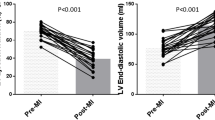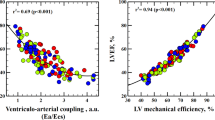Abstract
The end systolic pressure–volume relation (ESPVR) has been shown to be a relatively load independent measure of left ventricular (LV) contractility. Recently, several single-beat ESPVR computation methods have been developed, enabling the quantification of LV contractility without the need to alter vascular loading conditions on the heart. Using a single-beat ESPVR method, which has been validated previously in humans and assumes that normalized elastance is constant between individuals of a species, we studied the effects of myocardial infarction on LV contractility in two species, the rat and the pig. In our studies, LV pressure was acquired invasively and LV volume determined noninvasively with magnetic resonance imaging, at one week postinfarction in pigs and at 12 weeks postinfarction in rats. Normalized systolic elastance curves in both animal species were not statistically different from that of humans. Also, the slope of the ESPVR \(\left( {E_{es} } \right)\) decreased significantly following infarction in both species, while the volume-axis intercept \(\left( {V_0 } \right)\) was unaffected. These results indicate that a single-beat ESPVR method can be used to measure the inotropic response of the heart to myocardial infarction, and that the basis for this method (i.e., constant normalized elastance) is applicable to a variety of mammalian species. © 2000 Biomedical Engineering Society.
PAC00: 8719Uv, 8761Lh, 8719Hh, 8719Rr, 8719Ff
Similar content being viewed by others
REFERENCES
Borow, K. M., A. Neumann, and J. Wynne. Sensitivity of end-systolic pressure-dimension and pressure-volume relations to the inotropic state in humans. Circulation 65:988–997, 1982.
Burkhoff, D., S. Sugiura, D. T. Yue, and K. Sagawa. Contractility-dependent curvilinearity of end-systolic pressure-volume relations. Am. J. Physiol. 252:H1218-H1227, 1987.
Dell'Italia, L. J., G. G. Blackwell, F. Urthaler, D. J. Pearce, and G. M. Pohost. A stable model of left ventricular dysfunction in an intact animal assessed with high fidelity pressure and cinemagnetic resonance imaging. Cardiovasc. Res. 27:974–979, 1993.
Fifer, M. A., and E. Braunwald. End-systolic pressurevolume and stress-length relations in the assessment of ventricular function in man. In: Advances in Cardiology, edited by D. H. Spodick. Karger, 1985, pp. 36–55.
Gorcsan, J., A. Denault, W. A. Mandarino, and M. R. Pinsky. Left ventricular pressure-volume relations with transesophageal echocardiographic automated border detection: Comparison with conductance-catheter technique. Am. Heart J. 131:544–552, 1996.
Jerzewski, A., P. M. T. Pattynama, P. Steendijk, B. P. J. Leeuwenburgh, A. de Roos, and J. Baan. Differential response of the right and left ventricle to B-adrenergenic stimulation: An echo planar MR study in intact animals. J. Comput. Assist. Tomogr. 22:569–576, 1998.
Kass, D. A., and W. L. Maughan. From “Emax” to pressure-volume relations: A broader view. Circulation 77:1203–1212, 1988.
Kass, D. A., P. Marino, W. L. Maughan, and K. Sagawa. Determinants of end-systolic pressure-volume relations during acute regional ischemia in situ. Circulation 80:1783–1794, 1989.
Kass, D. A., R. Beyar, E. Lankford, M. Heard, W. L. Maughan, and K. Sagawa. Influence of contractile state on curvilinearity of in situ end-systolic pressure-volume relations. Circulation 79:167–178, 1989.
Kim, K. M., D. S. Lee, J. K. Chung, M. C. Lee, and Y. J. Kim. Noninvasive measurement of left ventricular contractility using gated myocardial SPECT and arterial pressure tonometer. IEEE Eng. Med. Biol. Mag. 20:517–519, 1998.
Lorenz, C. H., R. E. Henson, M. Creemers, S. E. Fischer, and S. A. Wickline. Regional ventricular function can be quanti-fied in the rat and mouse with a 1.5T whole-body MR scanner. Proceedings of ISMRM 1997, p. 884.
Lorenz, C. H., E. S. Walker, V. L. Morgan, S. S. Klein, and T. P. Graham. Normal human right and left ventricular mass, systolic function, and gender differences by cine magnetic resonance imaging. J. Cardiovasc. Magn. Reson. 1:7–21, 1999.
Lorenz, C. H., R. E. Henson, J. S. Allen, R. M. Setser, S. E. Fischer, and S. A. Wickline. Accurate quantification of myocardial mass in the rat using cine MRI at 1.5T. Proceedings of ISMRM 1998, p. 924.
Nakajima, H., H. O. Nakajima, R. L. Hammond, G. A. Thomas, S. Isoda, H. Lu, L. W. Stephenson, and F. A. Baciewicz. Chronic changes of end systolic pressure-volume relationship after regional myocardial infarction. J. Cardiovasc. Surg. 10:652–664, 1995.
Pfeffer, M. A., and E. Braunwald. Ventricular remodeling after myocardial infarction: Experimental observations and clinical implications. Circulation 81:1161–1172, 1990.
Pfeffer, M. A., J. M. Pfeffer, M. C. Fishbein, P. J. Fletcher, J. Spadaro, R. A. Kloner, and E. Braunwald. Myocardial infarct size and ventricular function in rats. Circ. Res. 44:503–512, 1979.
Sato, T., T. Shishido, H. Miyashita, R. Yoshimura, and K. Sunagawa. Single beat estimation of end-systolic elastance (E es ) in rats. Circulation 86:I-518, 1997.
Sato, T., T. Shishihdo, T. Kawada, H. Miyano, H. Miyashita, M. Inagaki, M. Sugimachi, and K. Sunagawa. ESPVR of in situ rat left ventricle shows contractility-dependent curvilinearity. Am. J. Physiol. 274:H1429-H1434, 1998.
Senzaki, H., C. H. Chen, and D. A. Kass. Single-beat estimation of end-systolic pressure-volume relation in humans: A new method with the potential for noninvasive application. Circulation 94:2497–2506, 1996.
Shishido, T., K. Hayashi, K. Shigemi, T. Sato, and K. Sunagawa. Prediction of end-systolic elastance on the basis of systolic time intervals and bilinearly approximated timevarying elastance. Circulation 86:I-518, 1997.
Sodums, M. T., F. R. Badke, M. R. Starling, W. C. Little, and R. A. O'Rourke. Evaluation of left ventricular contractile performance utilizing end-systolic pressure-volume relationships in conscious dogs. Circ. Res. 54:731–739, 1984.
Suga, H., and K. Sagawa. Instantaneous pressure-volume relationships and their ratio in the excised, supported canine left ventricle. Circ. Res. 35:117–126, 1974.
Suga, H., K. Sagawa, and A. A. Shoukas. Load independence of the instantaneous pressure-volume ratio of the canine left ventricle and effects of epinephrine and heart rate on the ratio. Circ. Res. 32:314–322, 1973.
Sunagawa, K., W. L. Maughan, and K. Sagawa. Effect of regional ischemia on the left ventricular end-systolic pressure-volume relationship of isolated canine hearts. Circ. Res. 52:170–178, 1983.
Sunagawa, K., W. L. Maughan, G. Friesinger, P. Guzman, M. Chang, and K. Sagawa. Effect of coronary arterial pressure on left ventricular end-systolic pressure-volume relation of isolated canine heart. Circ. Res. 50:727–734, 1982.
Sunagawa, K., A. Yamada, Y. Senda, Y. Kikuchi, M. Nakamura, T. Shibahara, and Y. Nose. Estimation of the hydromotive source pressure from ejecting beats of the left ventricle. IEEE Trans. Biomed. Eng. 27:299–305, 1980.
Takeuchi, M., Y. Igarashi, S. Tomimoto, M. Odake, T. Hayashi, T. Tsukamoto, K. Hata, H. Takaoka, and H. Fukuzaki. Single-beat estimation of the slope of the end-systolic pressure-volume relation in the human left ventricle. Circulation 83:202–212, 1991.
Vaughn, D. E., and M. A. Pfeffer. Post-myocardial infarction ventricular remodeling: Animal and human studies. Cardiovasc. Drugs Ther. 8:453–460, 1994.
Wannenburg, T., S. P. Schulman, D. Burkhoff. End-systolic pressure-volume and MVO2-pressure-volume area relations of isolated rat hearts. Am. J. Physiol. 262:H1287-H1293, 1992.
Author information
Authors and Affiliations
Rights and permissions
About this article
Cite this article
Setser, R., Henson, R.E., Allen, J.S. et al. Left Ventricular Contractility is Impaired Following Myocardial Infarction in the Pig and Rat: Assessment by the End Systolic Pressure–Volume Relation Using a Single-Beat Estimation Technique and Cine Magnetic Resonance Imaging. Annals of Biomedical Engineering 28, 484–494 (2000). https://doi.org/10.1114/1.289
Issue Date:
DOI: https://doi.org/10.1114/1.289




